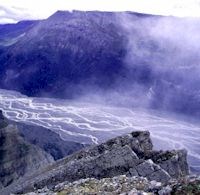
Wrangell-St. Elias National Park & Preserve is an icy, rocky wilderness where only the hardiest survive. Rivers bring life to the region by providing animals, plants, and humans with food and navigable pathways. Rivers provide a metaphor for the powerful forces that have created and continue to shape this dramatic landscape of tall peaks and rugged valleys. The Copper River The Copper River begins on Mount Wrangell at the terminus of the Copper Glacier and flows approximately 280 miles to its mouth at the Copper River Delta near Cordova. Rivers of Life Several types of freshwater fish live in the rivers and waterhseds of Wrangell-St. Elias. Salmon returning from the sea deposit their eggs in mountain streams, bringing a gift of life. And in their death comes life as well. Their decomposing bodies become food for other animals and enrichment for streamside soil and plants. Everything that lives here, from the smallest vole to the majestic Dall sheep, is connected to each other and to these flowing waters. 
Springing From Glaciers - Braided Rivers Glacial streams begin in the high mountains where they stay frozen all winter, but melt when days lengthen and become warmer. As water flow and momentum increase, a trickling stream can become a powerful river, carrying sand, rocks, and even boulders as it flows over and through rocky glacial debris. These rivers, carrying large sediment loads, often form a tangled network of bars, channels, and islands. They are called braided rivers. Many of the rivers within the park show this braided characteristic. The rivers' cold temperatures, hidden depths, and huge sediment loads are potentially dangerous to hikers trying to cross them. Learn about safe river crossing on the Backcountry Safety web page. |
Last updated: October 7, 2024
